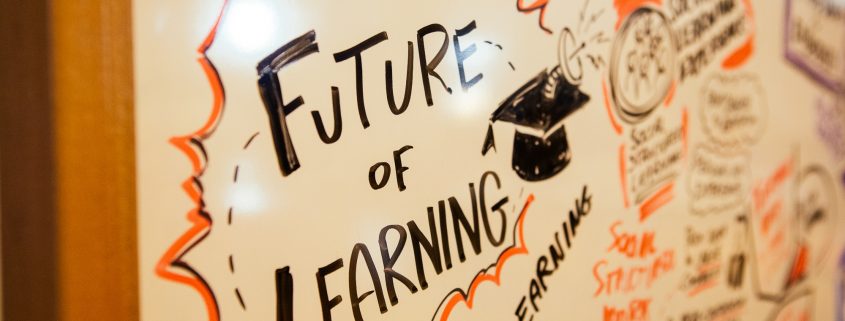Graphic Facilitation, what is it all about?
/Tomorrow 35 colleagues will participate in the Centre’s first graphic facilitation workshop. To know what it all is about and to give you a visual taste we interviewed the facilitator, Nancy White.

1. What is visual facilitation all about?
Graphic or visual facilitation is the intentional use of visual practices, including drawing, using pre-made visual artifacts and other forms, by an individual or by members of the group to support the group’s process. Some of the intentions behind visual facilitation include:
•using visuals as sense-making tools
•using the negotiability of images to think together when words (written/spoken) may block us
•the value of people creating a shared artifact of their work/learning/experience • the power of “making my mark” as an individual in a group
•using as many of our senses as is useful in a particular context
Graphic facilitation is different from graphic recording, which is the visual capture of what is being said in a room. We can use graphic recording as a way to enhance and facilitate meetings, but with graphic facilitation we are using visuals to enhance all the processes in the room. So it is less about making something beautiful, but to make beautiful interactions within a group. In the Centre’s case, this might mean making beautiful learning!
Finally, while drawing is a key element of graphic facilitation, it is NOT the only thing. We use visuals such as post-it notes for learners to take ownership and write and move their own ideas. We vote with colored dots. We use “red, yellow, green” cards for real time presentation feedback. The ideas from Gamestorming by Dave Gray (and this nifty Gamestorming design kit ). These are all visual methods. AND, you don’t have to be an artist even if you ARE drawing. Look at the amazing work of Dan Roam and Mike Rhode who inspire even the most rudimentary doodlers in us.
2. Why is it important?
There are many reasons visual facilitation is important. First of all we have the cognitive value. Our human brains react not just to words (spoken or written) but to images, sounds and even the kinesthetic experience we have as we interact with each other. So including the visual aspects into learning and doing things together enhances a group’s practice and results.
Second, visuals help us both in meaning making and in our working relationships with each other. I work internationally a lot and I’ve found visual facilitation does some wonderful things around the issues of power and language. Pictures, unlike words in so many cultures, are often perceived as less precise, or negotiable. When someone says “blah blah blah blah” we tend to either THINK we understand them, or if we don’t we may resist saying something at the risk of “looking stupid, ” especially in contexts of power and in hierarchies. We may not even be listening.
When someone doodles a little picture on a napkin or flip-chart, we sit up and take notice. We begin to wonder, ESPECIALLY if it is imperfect, and we can more easily say “what do you mean by that.” We have gone into the place of discussability and negotiation of meaning, the place of learning and understanding. This is a HUGE benefit to groups. Wonder can jump start listening and deeper conversation.
Discussability also helps bridge linguistic gaps. When we are working with groups who do not share a home language, we can miss meaning. The pictures slow us down just enough to find out if we are or are not talking about the same thing.
Finally, there is something about visuals that raises the energy in a room, helps us focus our attention and is just plain FUN. This supports engagement, ownership and, well, I’ll say it again, contributes fun. I think that is real and legitimate so I’m not afraid to say that three letter word. FUN!
So we get cognitive benefits, we get power-leveling benefits, we get meaning making benefits, we increase engagement and we have fun. THAT is a lot of value! If you want more peeks into this sort of thinking, check out Nancy Duarte’s “Resonate” – there are some bits online and the following link has some great videos. http://www.duarte.com/book/resonate/#www
We live in a visual world and up to today training is still very much relying on text-based materials and facilitation aids.What added value can visual facilitation bring to a training Centre?
Beyond making learning beautiful? Let’s start with the one people often least expect: listening. I want to share a great quote from Avril Orloff, an amazing visual facilitator and one of my mentors, about the role of visuals in listening.
“Any event that convenes a conversation == whether it’s a strategic planning session, a community engagement process, a workshop, or a dialogue between stakeholders — is only as successful as the quality of the listening taking place. “
We often think of the visuals as the content of the curriculum, but they are also “receptacles” of interaction. They can be a rich part of our process. Visuals help both the teacher and the learner to listen to each other and, when the conversational artifacts are captured as a visual practice, to show that people have been heard. We can use them between participants to foster better small group work, especially with people who are shyer to talk, or may need to stimulate other parts of their brain to engage and learn. Consider what would happen if you captured learner feedback on a white board visually (not just words) to help understand their understanding, and to demonstrate your listening as a teacher — what kind of a reaction might you expect from the learners? I bet it will be very gratifying and enlightening. I often use paired drawings (learned from Johnnie Moore) between participants as a way to get to know each other and engage in deeper conversation.
Second, think about visuals to frame content, process and meaning making. I’m not just talking about making your PowerPoint presentations more visually attractive. That is certainly a benefit (see how I drew my slides here), but I think it is important to think about visuals changing HOW we teach and learn and certainly step beyond presentation and delivery of content as the center. Here are just a few of the many things you can do.
•Visuals can be an amazing way to plan your curriculum. I’m really enjoying how the folks at Liberating Structures have used what they call Design Storyboarding . (You even have an example on your blog where Tod Harple said “I was also being very visual–rolling a whiteboard into her office so that we could “visualize” as we thought out loud. In this way, we were able to quickly frame the key components of the results and consider the narrative or story of how we would express them.) We can use a visual time line to provide a course overview to show sequence, or even options and alternatives. We can use a visual “make your own” agenda with post its for learners to suggest and prioritize what they want to learn. (Post Its, flip chart, pens… voila!)
•Visuals can be used by the teacher and the learners for organizing ideas, particularly with complicated subjects. Think of a mind map to outline a set of ideas, or to capture learner input. Some learners are using personal sketchnoting to take notes that have more meaning for them, and prompt better recall than text notes.
•Visuals can be part of interactive practices with small and large groups. A human spectrogram is both visual and kinesthetic, yet never lifts a single pen, all the while the group is helping making its insights or knowledge “visible” to you and to each other! Visuals are particularly good at helping draw out ideas. Check out “Drawing Together.” This quote from that page is too good NOT to share.
“Drawing together makes it possible to access hidden knowledge. Hidden knowledge may include feelings and patterns difficult to express with words. When people are tired, their brains are full, and you have reached the limits of logical thinking, drawing together can evoke ideas that precede logical, step-by-step understanding of what is possible. Stories about individual or group transformations can be told with five easy-to-draw symbols. Each symbol has a universal meaning. Being playful signals you are allowing for unlimited possibility and many right answers. Over-reliance on writing and what people say can limit novelty!”
•Visual practices can be a key element in reflective and evaluative processes. Think about visuals as a way to test and apply ideas. You can use card sorting exercises and dotmocracy to help learners sift and make sense of content. You can do a visual reflection exercise with the River of Life (we may use this to evaluate our time together in Torino!) You can have learners map their next steps – literally.
•Finally, when we think of ourselves as teachers, visuals ask us to step out of our possible “ruts” of the strings of words we have gotten so good at delivering. They ask us to challenge our own thinking and express ourselves in new ways. That often triggers new insights for ourselves, not just our students. Visuals are a discovery pathway, even a vector for innovation.
3 books to read?
These days, I’m torn to pick three. I want to rebel! I probably would put different books every day of the week, but here goes… (AND look at the larger list linked here!)
•Brandy Agerbeck’s , How to use your listening, thinking and drawing skills to make meaning
•David Sibbet’s How Graphics, Sticky Notes and Idea Mapping Can Transform Group Productivity
•Dave Gray’s Gamestorming
3 must-read articles?
Oh, Tom, this is really not fair! There are so many aspects to the practice, and it is blossoming right now, so there is something interesting everyday. I’d suggest people join the RosViz10 group where we link stuff as it emerges. Then they can be “in the flow” with the rest of us. The Graphic Facilitation group is also terrific.
2 must-see websites?
The International Forum of Visual Practitioners is the professional development hub http://ifvpcommunity.ning.com/ and The Center for Graphic Facilitation is another great aggregator of emerging material across the practice http://graphicfacilitation.blogs.com/ There is also a strong European community, but I’m less well connected to them. I’m asking my network for their recommendations and will let you know. And of course, my crazy little wiki of resources http://onlinefacilitation.wikispaces.com/Visual+Work+and+Thinking
I also have a bit more linked here.












Visual overview of the workshop: https://plus.google.com/photos/+NancyWhite/albums/5975524176540316449?gpinv=AMIXal9-M-j55WRBsOuTul23TURrHnMutId630k8Thm2Y4yYGAiBY6jmAYS44I05bPKkWKG219tn5sYVJ2Xas8XIqwXtl9ED89tyLApVrfM0vIhcLPc-T88&cfem=1%3Fgpinv=AMIXal9-M-j55WRBsOuTul23TURrHnMutId630k8Thm2Y4yYGAiBY6jmAYS44I05bPKkWKG219tn5sYVJ2Xas8XIqwXtl9ED89tyLApVrfM0vIhcLPc-T88
Another good resource on visual facilitation is this blog post by Beth Kanter: http://www.bethkanter.org/visual-meetings/. Also good this example on how to use Storify to do visual recording after a meeting/workshop: https://storify.com/kanter/visual-meeting-facilitation
[…] visual techniques are applied today in many fields: visual storytelling, visual facilitation, mind map and visual learning are some methods that enable you to visualise the […]
[…] a guest contribution of Nancy White on graphic facilitation we have a new guest post on the same topic from Leen De […]